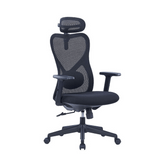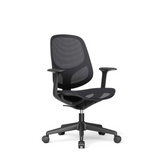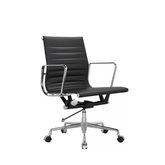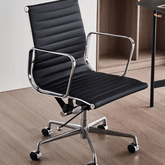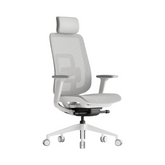Unveiling the Secrets of Ergonomic Chairs: Enhancing Comfort and Productivity
Introduction
In today's fast-paced world, where many of us spend hours sitting at our office desks, it's essential to prioritize our working environment comfort and well-being. One way to achieve this is by investing in an ergonomic office chair. But what exactly does the term "ergonomic" mean? In this article, we will delve into the world of ergonomic chairs, exploring their definition, benefits, and key features. By understanding what makes a chair ergonomic and how it can positively impact your work environment, you can make an informed decision when choosing the right chair for your needs. Let's embark on a journey to unravel the secrets of ergonomic chairs!
Table of Contents:
- The Significance of Ergonomic Chairs
- Defining Ergonomics
- Key Features of Ergonomic Chairs
- Adjustable Seat Height
- Lumbar Support
- Armrests
- Seat Depth and Width
- Swivel Base
- Breathable Material
- Benefits of Using an Ergonomic Chair
- Improved Posture and Spinal Alignment
- Enhanced Comfort and Reduced Discomfort
- Increased Productivity and Focus
- Prevention of Musculoskeletal Disorders
- Customizable to Individual Needs
- Conclusion
- Frequently Asked Questions (FAQ)
1. The Significance of Ergonomic Chairs
In today's modern work culture, where sedentary lifestyles are prevalent, ergonomic chairs have gained significant importance. These chairs are designed to provide optimal support and comfort, promoting a healthy sitting posture and reducing the risk of musculoskeletal issues. By investing in an ergonomic chair, you can create a conducive work environment that prioritizes your well-being and enhances your productivity.
2. Defining Ergonomics
Before diving into the specifics of ergonomic chairs, let's first understand the concept of ergonomics. Ergonomics is the science of designing products and environments to fit the needs and capabilities of the individuals using them. In the context of chairs, ergonomics focuses on creating seating solutions that support the natural curves and alignment of the human body, minimizing strain and discomfort.
3. Key Features of Ergonomic Chairs
Ergonomic chairs are equipped with various features that contribute to their comfort and support. Here are some key features to look for when considering an ergonomic chair:
Adjustable Seat Height
An ergonomic chair allows you to adjust the seat height to match your desk height and ensure proper alignment of your knees and hips. This feature enables you to maintain a 90-degree angle at your knees and keep your feet flat on the floor, promoting good posture and reducing strain on your lower back.
Lumbar Support
Proper lumbar support is crucial for maintaining the natural curve of your lower spine. Ergonomic chairs often feature adjustable lumbar support, allowing you to customize the level of support based on your individual needs. This feature helps prevent lower back pain and promotes a healthy sitting posture.
Armrests
Ergonomic chairs typically come with adjustable armrests that support your arms and shoulders, reducing strain on your upper body. The armrests should be positioned at a height that allows your arms to rest comfortably and your shoulders to relax, promoting proper alignment and reducing tension.
Seat Depth and Width
The seat depth and width of an ergonomic chair should accommodate your body size and provide ample support. A seat that is too shallow or narrow can cause discomfort and restrict blood circulation. Opt for a chair with adjustable seat depth and width to ensure a proper fit for your body.
Swivel Base
A swivel base allows you to rotate and move freely within your workspace without straining your body. This feature enables easy access to different areas of your desk and reduces the need for excessive twisting or reaching, promoting a more efficient and comfortable work experience.
Breathable Material
Ergonomic chairs often feature breathable materials such as mesh or fabric that allow air circulation, preventing excessive heat and moisture buildup. This feature helps keep you cool and comfortable throughout long hours of sitting.
4. Benefits of Using an Ergonomic Chair
Investing in an ergonomic chair offers a multitude of benefits that contribute to your overall well-being and productivity. Here are some advantages of using an ergonomic chair:
Improved Posture and Spinal Alignment
Ergonomic chairs promote proper posture by providing support to the natural curves of your spine. By maintaining a neutral spine alignment, you can reduce the risk of developing poor posture habits and associated discomfort.
Enhanced Comfort and Reduced Discomfort
The ergonomic design of these chairs ensures optimal comfort by minimizing pressure points and providing adequate support to your body. This reduces discomfort and fatigue, allowing you to focus on your work without distractions.
Increased Productivity and Focus
When you are comfortable and free from pain or discomfort, your concentration and productivity levelsare likely to increase. Ergonomic chairs enable you to maintain a comfortable and supported position, reducing the need for frequent adjustments and distractions. This allows you to stay focused on your tasks and accomplish them more efficiently.
Prevention of Musculoskeletal Disorders
Prolonged sitting in an improper posture can lead to musculoskeletal disorders such as back pain, neck strain, and shoulder tension. Ergonomic chairs help prevent these issues by providing proper support and promoting healthy sitting habits. By investing in an ergonomic chair, you can minimize the risk of developing long-term health problems associated with poor sitting posture.
Customizable to Individual Needs
One of the key advantages of ergonomic chairs is their adjustability. These chairs can be customized to fit your unique body shape, size, and preferences. From seat height and depth to lumbar support and armrests, you can tailor the chair to your specific needs, ensuring maximum comfort and support.
5. Conclusion
In conclusion, ergonomic chairs are a valuable investment for anyone who spends a significant amount of time sitting at a desk. These chairs prioritize your comfort, well-being, and productivity by providing optimal support and promoting healthy sitting habits. With their adjustable features and ergonomic design, they help prevent musculoskeletal disorders and enhance your overall work experience. By choosing an ergonomic chair, you are making a conscious decision to prioritize your health and create a conducive work environment. So, why settle for discomfort and potential health issues when you can enjoy the benefits of an ergonomic chair?
6. Frequently Asked Questions (FAQ)
Q1: How do ergonomic chairs differ from regular chairs?
Ergonomic chairs are specifically designed to provide optimal support and comfort, taking into consideration the natural curves and alignment of the human body. They offer adjustable features such as seat height, lumbar support, and armrests, allowing you to customize the chair to your individual needs. Regular chairs, on the other hand, may lack these ergonomic features and may not provide the same level of support and comfort.
Q2: Can ergonomic chairs help alleviate back pain?
Yes, ergonomic chairs can help alleviate back pain by promoting proper posture and providing adequate lumbar support. These chairs are designed to support the natural curve of your spine, reducing strain on your back and minimizing discomfort. However, it's important to note that an ergonomic chair alone may not be a complete solution for back pain. It's recommended to incorporate regular breaks, stretching exercises, and other ergonomic practices into your daily routine for optimal results.
Q3: Are ergonomic chairs suitable for everyone?
Ergonomic chairs are designed to accommodate a wide range of body types and sizes. However, it's essential to choose a chair that suits your specific needs and preferences. Factors such as height, weight, and any existing medical conditions should be taken into consideration when selecting an ergonomic chair. If possible, it's advisable to try out different chairs before making a purchase to ensure the best fit for your body.
Q4: Can ergonomic chairs improve productivity?
Yes, ergonomic chairs can improve productivity by providing comfort and reducing discomfort. When you are comfortable and free from distractions such as pain or discomfort, you can focus better on your tasks and work more efficiently. The adjustability and support offered by ergonomic chairs contribute to a more conducive work environment, allowing you to stay focused and productive throughout the day.
Q5: How do I choose the right ergonomic chair for me?
Choosing the right ergonomic chair involves considering factors such as adjustability, lumbar support, seat size, and material. Look for chairs that offer a wide range of adjustments to accommodate your body size and preferences. Consider the level of lumbar support provided and ensure that the seat size and material are suitable for your comfort. It's also helpful to read reviews and seek recommendations from professionals or colleagues who have experience with ergonomic chairs.
Remember, investing in an ergonomic chair is an investment in your health and well-being. By prioritizing your comfort and creating a supportive work environment, you can enhance your productivity and overall quality of life. So, why wait? Take the first step towards a healthier and more comfortable work experience by choosing an ergonomic chair today!
Disclaimer: The information provided in this article is for educational purposes only and should not be considered as professional advice. Consult with a healthcare professional or ergonomic specialist for personalized recommendations.
Gavisco Premium Office Furniture - Elevate Your Workspace
